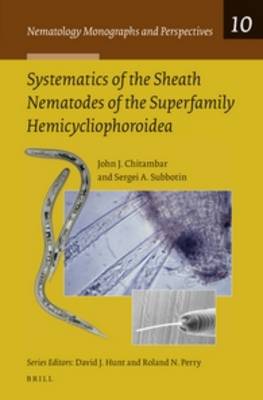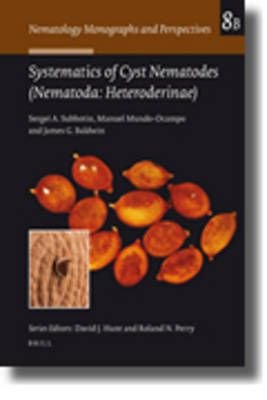Nematology Monographs and Perspectives
1 primary work • 5 total works
Book 10
Systematics of the Sheath Nematodes of the Superfamily Hemicycliophoroidea
by J.J. Chitambar and Sergei A. Subbotin
Published 11 April 2014
The sheath nematodes belonging to the superfamily Hemicycliophoroidea are unique amongst all plant parasitic nematodes known to man due to the presence of an extra cuticular covering or sheath over the inner cuticle and body of all juvenile and adult life stages. These plant-parasitic nematodes include species of agricultural and quarantine importance.
In Systematics of the Sheath Nematodes of the Superfamily Hemicycliophoroidea John Chitambar and Sergei Subbotin provide a detailed review of the taxonomy and diagnosis of the superfamily, its member genera and 153 related species based on their morphological and molecular analyses, as well as a further understanding of the relationships within the superfamily using molecular phylogenetics. In addition, Chitambar and Subbotin also give detailed information on the global distribution, biology, host-parasite relationships and ecology of sheath nematodes.
In Systematics of the Sheath Nematodes of the Superfamily Hemicycliophoroidea John Chitambar and Sergei Subbotin provide a detailed review of the taxonomy and diagnosis of the superfamily, its member genera and 153 related species based on their morphological and molecular analyses, as well as a further understanding of the relationships within the superfamily using molecular phylogenetics. In addition, Chitambar and Subbotin also give detailed information on the global distribution, biology, host-parasite relationships and ecology of sheath nematodes.
8A
Systematics of Cyst Nematodes (Nematoda: Heteroderinae), Part A
by Sergei A. Subbotin and J Baldwin
Published 23 August 2010
Volume 8 in the series, appearing in two parts, A and B, deals with the systematics of cyst nematodes of the subfamily Heteroderinae. Cyst nematodes are important pathogens causing extensive damage and significant yield loss to many crops in both temperate and tropical regions. Part A presents summarised information on various aspects of morphology, biology, ecology, pathology, biogeography, control measures and diagnostics of these nematodes. Molecular diagnostic tables and comprehensive tabular and dichotomous keys for species identification, together with descriptions of protocols for extraction, light and electron microscopy studies, and molecular diagnostics are also included. The taxonomic section of part A provides diagnoses for six genera, viz., Globodera, Punctodera, Cactodera, Dolichodera, Betulodera and Paradolichodera, and includes descriptions and morphometrics of 30 valid species. The work is illustrated by 101 drawings and photos. The genus Heterodera is mainly covered in part B, complete descriptions and morphometrics of the 80 known valid species being provided and the species illustrated by 159 line drawings and photos. Identification of the species using morphological and molecular techniques is also covered. Each part includes an extensive bibliography.
8B
Systematics of Cyst Nematodes (Nematoda: Heteroderinae), Part B
by Sergei A. Subbotin and J Baldwin
Published 23 August 2010
Volume 8 in the series, appearing in two parts, A and B, deals with the systematics of cyst nematodes of the subfamily Heteroderinae. Cyst nematodes are important pathogens causing extensive damage and significant yield loss to many crops in both temperate and tropical regions. Part A presents summarised information on various aspects of morphology, biology, ecology, pathology, biogeography, control measures and diagnostics of these nematodes. Molecular diagnostic tables and comprehensive tabular and dichotomous keys for species identification, together with descriptions of protocols for extraction, light and electron microscopy studies, and molecular diagnostics are also included. The taxonomic section of part A provides diagnoses for six genera, viz., Globodera, Punctodera, Cactodera, Dolichodera, Betulodera and Paradolichodera, and includes descriptions and morphometrics of 30 valid species. The work is illustrated by 101 drawings and photos. The genus Heterodera is mainly covered in part B, complete descriptions and morphometrics of the 80 known valid species being provided and the species illustrated by 159 line drawings and photos. Identification of the species using morphological and molecular techniques is also covered. Each part includes an extensive bibliography.
Systematics of Cyst Nematodes (Nematoda: Heteroderinae), Volume 8 Part B
by J Baldwin, Sergei Subbotin, and M Mundo-Ocampo
Published 1 January 2010
Systematics of Cyst Nematodes (Nematoda: Heteroderinae), Volume 8 Part A & B
by Sergei A. Subbotin and J Baldwin
Published 1 January 2010
Volume 8 in the series, appearing in two parts, A and B, deals with the systematics of cyst nematodes of the subfamily Heteroderinae. Cyst nematodes are important pathogens causing extensive damage and significant yield loss to many crops in both temperate and tropical regions. Part A presents summarised information on various aspects of morphology, biology, ecology, pathology, biogeography, control measures and diagnostics of these nematodes. Molecular diagnostic tables and comprehensive tabular and dichotomous keys for species identification, together with descriptions of protocols for extraction, light and electron microscopy studies, and molecular diagnostics are also included. The taxonomic section of part A provides diagnoses for six genera, viz., Globodera, Punctodera, Cactodera, Dolichodera, Betulodera and Paradolichodera, and includes descriptions and morphometrics of 30 valid species. The work is illustrated by 101 drawings and photos. The genus Heterodera is mainly covered in part B, complete descriptions and morphometrics of the 80 known valid species being provided and the species illustrated by 159 line drawings and photos. Identification of the species using morphological and molecular techniques is also covered. Each part includes an extensive bibliography.



